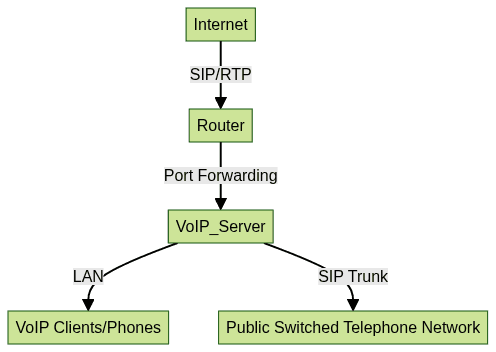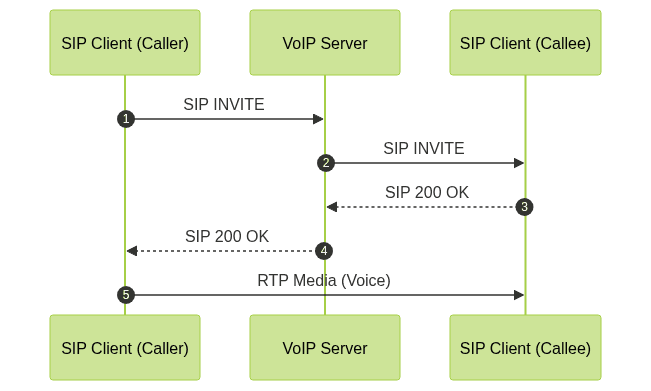Introduction to VoIP Servers
Voice over IP (VoIP) technology is revolutionizing the way we communicate in 2025, enabling voice, video, and messaging over digital networks. For developers, IT professionals, and businesses, setting up a VoIP server offers flexible, cost-effective, and scalable communication solutions compared to traditional telephony. Knowing how to setup a VoIP server empowers you to create custom PBX systems, integrate voice with software, and optimize communications for both home and enterprise environments. This guide will walk you through the essentials of VoIP server setup, management, and troubleshooting using modern tools and best practices.
What is a VoIP Server?
A VoIP server is a specialized system that manages and routes voice, video, and messaging data over IP networks. Acting as the backbone of any VoIP deployment, it handles call signaling, user authentication, codec negotiation, call routing, and often voicemail or conferencing features. VoIP servers can support protocols like SIP, IAX, and WebRTC, making them versatile in modern unified communications. For developers building mobile apps, exploring
webrtc android
integration can be particularly valuable for enabling real-time communication on Android devices. They are crucial for businesses seeking to replace or supplement traditional telephony with robust, internet-based systems.Types of VoIP Servers
On-Premises VoIP Servers
On-premises VoIP servers are installed and managed locally within your organization’s infrastructure. They provide full control over configuration, security, and data privacy, but require dedicated hardware, network management, and ongoing maintenance. Open source solutions like Asterisk or FreeSWITCH are popular choices for on-premises deployments, and you can further enhance your VoIP applications by leveraging a
Voice SDK
for advanced audio features.Cloud-Based VoIP Servers
Cloud-based VoIP servers are hosted on external platforms or public clouds like AWS, Azure, or Google Cloud. They offer rapid deployment, scalability, and reduced hardware costs. Managed services handle maintenance, but you may have less granular control over configuration and security. For teams looking to quickly add video capabilities, using a
Video Calling API
can streamline the integration process.Hybrid VoIP Solutions
Hybrid VoIP combines on-premises and cloud-based elements, providing flexibility and redundancy. Often used by businesses needing both in-house control and external scalability, hybrid solutions can balance cost, performance, and disaster recovery needs. If you want to embed video communication directly into your platform, consider using an
embed video calling sdk
for a seamless user experience.Prerequisites for Setting Up a VoIP Server
Hardware Requirements
- Multi-core CPU (Intel/AMD, ARM for smaller deployments)
- Minimum 2GB RAM (4GB+ recommended for business use)
- Reliable storage (SSD preferred for performance)
- Network interface card (1GbE or faster)
- Optional: Dedicated VoIP hardware (FXO/FXS cards, VoIP gateways)
Software Requirements
- Supported OS (Linux distributions like Ubuntu, Debian, CentOS; Windows for some solutions)
- VoIP server software (Asterisk, FreeSWITCH, 3CX, Murmur for Mumble, etc.)
- Required dependencies (e.g., libpri, dahdi for Asterisk)
- Basic text editor (nano, vim, Notepad++)
If you're building cross-platform apps, exploring
flutter webrtc
can help you implement real-time communication on both Android and iOS.Network Infrastructure
- Stable broadband connection
- Properly configured routers/switches
- Static IP or dynamic DNS for remote access
- Open required ports for SIP/RTP, web interfaces
- Firewall and NAT rules for secure connectivity

Step-by-Step Guide: How to Setup VoIP Server
Step 1: Choose Your VoIP Software
There are several popular VoIP server software options:
- Asterisk: Open source, highly customizable, ideal for PBX and SIP trunking.
- FreeSWITCH: Scalable, modular, supports advanced features and protocols.
- 3CX: Commercial PBX solution, user-friendly, supports Windows and Linux.
- Murmur: VoIP server for Mumble, suited for gaming and low-latency chat.
- Others: Ventrilo, Kamailio, OpenSIPS.
Choose the platform that matches your technical skills, feature needs, and deployment scale. If you want to add phone functionality to your app, check out a
phone call api
to simplify integration.Step 2: Install the VoIP Server Software
Example: Installing Asterisk on Ubuntu Linux
1sudo apt update
2sudo apt install -y build-essential git wget subversion
3sudo apt install -y libncurses5-dev libssl-dev libxml2-dev
4cd /usr/src
5sudo wget https://downloads.asterisk.org/pub/telephony/asterisk/asterisk-20-current.tar.gz
6sudo tar xzf asterisk-20-current.tar.gz
7cd asterisk-20.*
8sudo ./configure
9sudo make
10sudo make install
11sudo make samples
12sudo make config
13sudo systemctl start asterisk
14sudo systemctl enable asterisk
15Example: Installing FreeSWITCH on Debian/Ubuntu
1sudo apt update
2sudo apt install -y freeswitch freeswitch-mod-conference freeswitch-lang-en
3sudo systemctl start freeswitch
4sudo systemctl enable freeswitch
5Example: Installing Murmur (Mumble Server)
1sudo apt update
2sudo apt install -y mumble-server
3sudo dpkg-reconfigure mumble-server
4sudo systemctl start mumble-server
5sudo systemctl enable mumble-server
6Step 3: Basic Configuration
Asterisk SIP Configuration Example (sip.conf)
1[general]
2disallow=all
3allow=ulaw,alaw
4defaultuser=asterisk
5bindport=5060
6bindaddr=0.0.0.0
7
8[1001]
9type=friend
10secret=yourpassword
11host=dynamic
12context=internal
13
14[1002]
15type=friend
16secret=anotherpassword
17host=dynamic
18context=internal
19Asterisk Dialplan Example (extensions.conf)
1[internal]
2exten => 1001,1,Dial(SIP/1001)
3exten => 1002,1,Dial(SIP/1002)
4exten => 2000,1,Voicemail(1001@default)
5If you're developing VoIP apps for iOS, following a
callkit tutorial
can help you integrate native call UI and system-level features for a better user experience.Step 4: Network Configuration
Proper network setup is essential for a functional VoIP server.
Firewall Settings (UFW Example)
1sudo ufw allow 5060/udp # SIP
2sudo ufw allow 10000:20000/udp # RTP
3sudo ufw allow 22/tcp # SSH
4sudo ufw enable
5Port Forwarding Example (Router)
Forward the following ports from your router to the VoIP server’s LAN IP:
- SIP: 5060/UDP
- RTP: 10000-20000/UDP
NAT Configuration in Asterisk (sip.conf)
1[general]
2nat=force_rport,comedia
3externip=your.public.ip.address
4localnet=192.168.1.0/255.255.255.0
5VoIP Call Flow Diagram

Step 5: Connecting Clients and Testing
Example: SIP Client Configuration (Zoiper, Linphone, IP Phone)
- Username: 1001
- Password: yourpassword
- SIP Server: your.server.ip.address
- Port: 5060
- Transport: UDP
Configure at least two clients and place a test call between them. For iOS developers, implementing a
callkit tutorial
ensures seamless call handling and system integration.Testing Calls
- Use software phones or hardware SIP phones to register accounts
- Place calls and check audio in both directions
- Use Asterisk CLI for troubleshooting:
1sudo asterisk -rvvv
2sip show peers
3sip set debug on
4Troubleshooting Tips
- Check firewall and NAT settings if clients cannot register
- Verify correct codecs are enabled (ulaw, alaw, opus)
- Monitor server logs for errors
- Use Wireshark or tcpdump for packet inspection if calls fail or audio drops
If you want to explore more about integrating native calling features, another
callkit tutorial
can provide step-by-step guidance for iOS VoIP apps.Essential VoIP Server Features and Management
Modern VoIP servers provide features such as call routing, call queues, IVR (Interactive Voice Response), voicemail, conferencing, and call recording. Management interfaces (web UI, CLI, REST APIs) simplify administration. Integration with directory services (LDAP, Active Directory) and CRM systems is also common. Security features include TLS/SRTP for encrypted calls and real-time monitoring for threat detection.
VoIP Server Security Best Practices
- Enforce strong passwords and authentication for all VoIP accounts
- Use firewalls to restrict access to SIP and management ports
- Regularly update server software to patch vulnerabilities
- Enable TLS/SRTP to encrypt signaling and media traffic
- Monitor logs and set up alerts for suspicious activity
- Disable unused services and ports to reduce attack surface
Troubleshooting Common Issues
VoIP servers can face issues like registration failures, one-way audio, echo, or dropped calls, often due to NAT, firewall misconfiguration, or codec mismatches. Always verify network settings, server logs, and use packet analysis tools to isolate and resolve problems efficiently.
Conclusion
Setting up a VoIP server in 2025 is achievable for IT professionals and hobbyists alike. With the right tools, configurations, and security, you can deploy a robust, scalable communication platform tailored to your needs. If you're ready to build your own solution,
Try it for free
and start experimenting with modern VoIP APIs and SDKs.Recommended Resources (Links)
Want to level-up your learning? Subscribe now
Subscribe to our newsletter for more tech based insights
FAQ